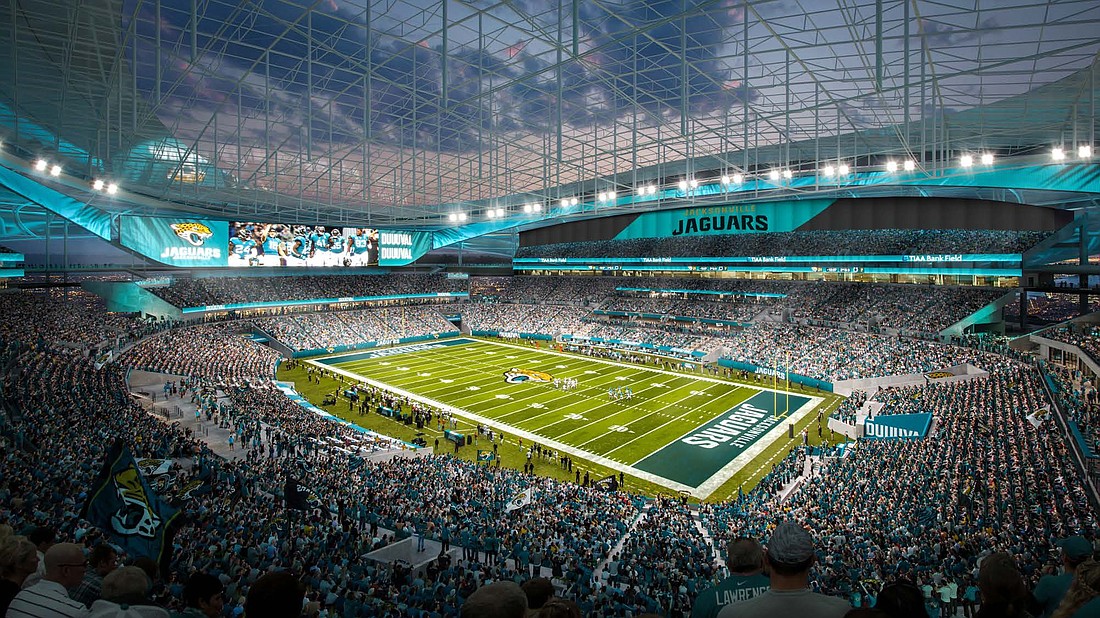
In their first public review of the proposed stadium deal between the city of Jacksonville and the Jacksonville Jaguars, City Council members sought details June 5 on such issues as the number of games the team would be required to play at home and how the city’s proposed funding mechanism for the new stadium would affect pension funds for city employees.
In a workshop at City Hall, Council members met with their auditors along with city officials and team administrators to begin parsing the $1.4 billion agreement to transform EverBank Stadium into the Jaguars’ “Stadium of the Future.”
The deal started off smoothly as the workshop ended nearly two hours early and an optional three-hour follow-up meeting June 6 was canceled.
Several Council members said that although they still had questions, they were encouraged by what they heard.

“I think it appears we have a deal that’s going to keep the Jaguars here and is fair to the citizens of Jacksonville and the taxpayers,” Council member Nick Howland said.
“I think we’re moving toward approval of the plan. Yes, I do,” said Council President Ron Salem.
In the workshop, Council members heard reports on the city’s plan to fund its $775 million contribution to the stadium project, a nonrelocation agreement that would require the team to repay the city’s funding if it leaves Jacksonville, and a guarantee agreement covering such issues as payments and interest.
The funding mechanism cleared a review by the Council Auditor’s office, which declared it “reasonable.”
Ending the Better Jacksonville Plan
The plan revolves around abandoning a strategy to call an early end to the Better Jacksonville Plan, a voter-approved sales tax increase to fund city infrastructure improvements over a 30-year period.
Mayor Lenny Curry’s administration had moved several projects out of the Better Jacksonville Plan and into the city Capital Improvement Plan, which is paid for mostly through borrowed funding.
The administration planned to end the Better Jacksonville Plan in 2026, four years earlier than it was permitted to be in effect. Ending the plan early would trigger the onset of a subsequent tax increase approved by voters to reduce the city’s unfunded pension liability.
To pay for its share of the stadium deal, the city would shift $600 million of projects out of the Capital Improvement Plan and pay for them with Better Jacksonville Plan revenue.
The city would then pay for stadium improvements out of the Capital Improvement Plan.
The auditor’s office agreed that projects could be shifted back to the Better Jacksonville Plan and reported that the approach would save the city $25 million annually in general fund expenses. The $25 million figure was derived from a $40 million savings in annual debt payments on the projects minus $15 million in pension contributions that would be saved if the pension liability tax increase took effect early.
Although the start of the pension tax would be delayed, the auditor’s office reported that it would pay down the pension debt liability several years before its sunset. Like the Better Jacksonville Plan, the tax increase was designed to be in effect for up to 30 years.
Confidence and questions
Council member Will Lahnen said that although he wanted to hear feedback on the plan from the boards of the city’s pension funds, he didn’t see any red flags in the approach.
“It’s $600 million in debt avoidance and $25 million additionally to our operating budget through 2030, which will allow us to do additional things within that budget,” Lahnen said.
“The pension still appears to be fully funded somewhere in the late 2040s or early 2050s.”

Council member Ken Amaro said he was “very satisfied and confident” in the auditors’ findings.
“This puts us in a good posture to not burden our city but get things done, so I’m comfortable in where we are.”
Discussion on the nonrelocation agreement focused largely on how many home games the Jaguars would be allowed to play in neutral stadiums elsewhere, such as the team’s annual game in London.
The agreement provides for one off-site home game per year in the NFL’s current 17-game season. If the NFL extends its seasons to 18 games or more, the Jaguars could play additional off-site games.
Council members expressed confusion about the contract language, pressing Jaguars President Mark Lamping to explain how many games the team could potentially play away from Jacksonville.
Lamping said the most would be six games in four years, regardless of the number of games the NFL may eventually add to its season.
“Under 18 games, we have the ability to play one game away in each four-year period, then have an option to play a game away every other year,” he said.
“If it goes to 19, 20, 25, 28, that doesn’t change.”

Council member Mike Gay questioned why the Jaguars’ couldn’t occasionally use a visiting game slot for their international games.
“In the game away in London, why does it go against our home games? Should it not be taken away from one of our away games?” he said.
“I would like to see that as some kind of consideration.”
Lamping said the Jaguars’ participation in international games helped burnish the team’s value to the NFL, an important consideration for a small-market franchise. He said the issue was a key point in the team’s negotiations, so much so that he recommended not discussing it early for fear it might create an impasse.
Lamping said the team was at the mercy of the NFL in being assigned to games played elsewhere. He warned against adding restrictions that would run counter to NFL policies, saying the league would “never approve the lease if those things exist.”
Seeking Council approval by fall
The team is seeking Council approval on the agreement before the October meeting of NFL owners, whose approval is needed for the construction to proceed.
The agreement before Council calls for the team and city to each contribute $625 million toward construction of the stadium, with the city providing an extra $150 million for deferred maintenance and capital improvements. The $150 million would prepare the stadium for the project and make it usable by the Jaguars after construction begins.
Another element of the package would see the team and city each contributing $150 million for community benefits including workforce development, affordable housing and homelessness services in the Eastside neighborhood and beyond.
The community benefits agreement would also include funding for development of riverfront parks.

Although earlier reports stated that the overall deal would include seven separate agreements, Salem said it would comprise nine. Updated deals involving the Miller Electric Performance Center and Daily’s Place also will be included.
Salem said he hoped to pass the full package by the end of June but had issues with the community benefits agreement. Other Council members have questioned the agreement, including Lahnen.
“Of the $150 million, $80 million is from our operating budget and $70 million is capital. So that’s a lot of incremental money,” he said.
The nonrelocation agreement makes the Jaguars liable for repaying the city’s contribution plus interest, provided the city first seek “equitable relief” that could include assets other than cash.
The agreement includes a sliding scale in which the Jaguars would repay 100% of the city’s funding if they leave during the first 14 years of the 30-year lease. From there, the obligation would decline steadily to 5% in the 29th year.
Kim Taylor, the lead Council auditor, raised a concern that the agreement was tied to the start of the lease in 2028 and did not contain protections for taxpayers during construction of the stadium.
The new stadium would include a roof cover that would protect seating areas from direct sunlight and rain; an elevated concourse; and expanded options for food and beverages, among other new amenities.